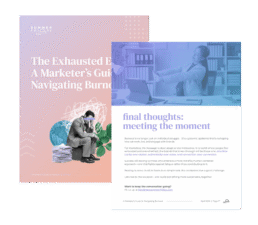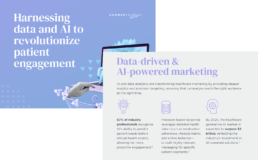Consumer Confidence: What it means for brands in 2025
consumer confidence:
what it means for brands in 2025

Consumer confidence is shifting–and so is the way people spend. In a world of economic uncertainty, understanding how consumers feel about their finances is more important than ever.
Our latest cheat sheet breaks down what’s driving consumer confidence, how shoppers are reacting today, and what brands can do to build lasting trust.
The basics
What consumer confidence is and why it matters to every marketer
Key drivers
From inflation to job trends to political climate and interest rates–see what’s shaping consumer sentiment today
How consumers are responding
Get the latest stats on spending habits, value-seeking, and what’s behind the shift to lower-priced brands
Click below to download
Ready to understand what’s driving consumer confidence in 2025? Download now and get the insights you need to engage today’s cautious, value-focused consumers.

For more resources like this, visit our Summer Friday Insights Page, where we share valuable ideas, inspiration, and strategies in marketing to foster meaningful discussions.
The Exhausted Era: A Marketer’s Guide to Navigating Burnout
The Exhausted Era:
A Marketer’s Guide to Navigating Burnout

Feeling like you’re running on empty? You’re not alone. Burnout isn’t just a personal struggle anymore; it’s a silent epidemic reshaping our workplace, our economy, our culture, and our very well-being.
For business leaders, marketers, and individuals alike, understanding burnout isn’t optional—it’s essential for survival and success in 2025. But what does this mean from a marketing perspective?
In this report, we dive into:
- Insights on burnout’s far-reaching impacts including mental and physical health
- Cultural and economic factors fueling the crisis
- Actionable strategies for consumers content burnout
- Forward-thinking approaches for content marketing in a stressed-out world
Download our report to learn more on what we as marketers can do to adapt to this burnt out world.
Click below to download our new report

As always, if you have any thoughts or questions on our report, hit us up at say@heysummerfriday.com
The Exhausted Era: A Marketer’s Guide to Navigating Burnout Sign-up
The Exhausted Era:
A Marketer’s Guide to Navigating Burnout

Feeling like you’re running on empty? You’re not alone. Burnout isn’t just a personal struggle anymore; it’s a silent epidemic reshaping our workplace, our economy, our culture, and our very well-being.
For business leaders, marketers, and individuals alike, understanding burnout isn’t optional—it’s essential for survival and success in 2025. But what does this mean from a marketing perspective?
In this report, we dive into:
- Insights on burnout’s far-reaching impacts including mental and physical health
- Cultural and economic factors fueling the crisis
- Actionable strategies for consumers content burnout
- Forward-thinking approaches for content marketing in a stressed-out world
Download our report to learn more on what we as marketers can do to adapt to this burnt out world.

As always, if you have any thoughts or questions on our report, hit us up at say@heysummerfriday.com
Short form content for the win!
short form content for the win!

In today’s fast-paced digital landscape, short-form content has become the ultimate tool for marketers to capture attention, drive engagement, and deliver results.
Here’s what you’ll find in our analysis on why short form content is so effective:
How to capture fast-paced minds with a shrinking attention span
How to engage the distracted consumer that is quickly scrolling through content
How to stand out with content in a saturated landscape
grab your copy
Want to learn more about the “why” behind short form content? Download our one pager and see how marketers can be more effective in their content.

For more resources like this, visit our Summer Friday Insights Page, where we share valuable ideas, inspiration, and strategies in marketing to foster meaningful discussions.
Smarter Healthcare Marketing Starts Here
smarter healthcare marketing starts here

The way people engage with healthcare is evolving—fast. Whether they’re looking up symptoms, scheduling virtual appointments, or scrolling social media for health advice, today’s patients expect seamless, digital-first experiences.
Here’s what you’ll find in our breakdown on the future of healthcare marketing:
Why AI and predictive insights are making healthcare marketing smarter
The rise of video, interactive content, and real-time engagement
How precision targeting is improving patient outreach and outcomes
grab your copy
Want to stay ahead of the curve? Download our quick-read one-pager and see how data and AI are engaging patients and healthcare professionals in smarter, more effective ways.

For more resources like this, visit our Summer Friday Insights Page, where we share valuable ideas, inspiration, and strategies in marketing to foster meaningful discussions.
Generational Cheat Sheet
stop guessing and start connecting
with audiences of all ages!

In today’s diverse, multi-generational world, one-size-fits-all communication just doesn’t cut it. So, we created a “cheat sheet”, your go-to guide for decoding generational audiences.
This comprehensive resource breaks down the key traits and expectations of each generation, empowering you to:
Craft content that resonates by speaking directly to their experiences.
Choose the right channels to meet them where they are.
Build meaningful connections that drive engagement and action.
Click below to download our cheat sheet
Whether you’re creating marketing campaigns, writing social media content, or building customer relationships, this cheat sheet will help you navigate the nuanced landscape of generational communication with confidence and clarity.

For more resources like this, visit our Summer Friday Insights Page, where we share valuable ideas, inspiration, and strategies in marketing to foster meaningful discussions.
Gen Alpha: The Independent Innovators Sign-up
Gen Alpha:
The Independent Innovators

Gen Alpha is more than just “iPad kids.” As they transition from childhood to adolescence, this tech-savvy generation is redefining independence, turning screen time into a catalyst for creativity and innovation.
Our report explores their socio-economic context, the rise of gaming culture, how technology has enabled their sense of autonomy, and how they’re breaking stereotypes to become the next wave of influencers. Discover how this remarkable generation is shaping the future.

Gen Alpha: The Independent Innovators
Gen Alpha:
The Independent Innovators

Gen Alpha is more than just “iPad kids.” As they transition from childhood to adolescence, this tech-savvy generation is redefining independence, turning screen time into a catalyst for creativity and innovation.
Our report explores their socio-economic context, the rise of gaming culture, how technology has enabled their sense of autonomy, and how they’re breaking stereotypes to become the next wave of influencers. Discover how this remarkable generation is shaping the future.
As always, if you have any thoughts or questions on our report, hit us up at say@heysummerfriday.com.
Click below to download our new report

The Carbon Cut: A Marketer’s Responsibility in Leading the Green Revolution Sign-up
The Carbon Cut:
A Marketer’s Responsibility in Leading the Green Revolution

To round out our four-part Sustainability Series, we explore the vital role marketers play in addressing the climate crisis. We’ll explore the broader challenge of decarbonization, how marketing contributes to emissions and the opportunities to reduce this impact.
We’ll also share actionable steps marketing teams can implement to reduce, remove, and offset their carbon footprint, and even share what we do here at Summer Friday.
We’re excited to share this final installment and look forward to continuing the journey toward a more sustainable world.

A Marketer’s Responsibility in Leading the Green Revolution
The Carbon Cut:
A Marketer’s Responsibility in Leading the Green Revolution

To round out our four-part Sustainability Series, we explore the vital role marketers play in addressing the climate crisis. We’ll explore the broader challenge of decarbonization, how marketing contributes to emissions and the opportunities to reduce this impact.
We’ll also share actionable steps marketing teams can implement to reduce, remove, and offset their carbon footprint, and even share what we do here at Summer Friday.
We’re excited to share this final installment and look forward to continuing the journey toward a more sustainable world.
As always, if you have any thoughts or questions on our four-part series, hit us up at say@heysummerfriday.com.
Click below to download our new report







